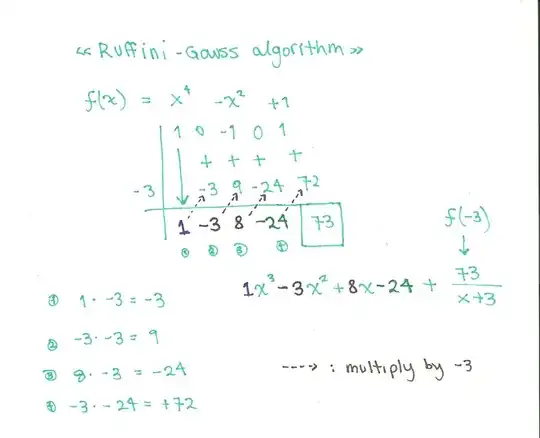Well, I put on Wolfram Alpha the equation $$\dfrac{x^4-x^2+1}{x+3}$$ and it tells me that this simplified is this:$$x^3-3x^2+8x+\frac{73}{x+3}-24$$ But I don't know how did he went there.
-
3http://en.wikipedia.org/wiki/Polynomial_long_division – Pedja Apr 27 '12 at 16:44
-
You know how to do synthetic division, yes? – J. M. ain't a mathematician Apr 27 '12 at 16:45
-
2By the way, you must have entered the expression in incorrectly. – David Mitra Apr 27 '12 at 16:46
-
2How can a third degree polynomial on division by a first degree polynomial yield back a third degree polynomial? – Tomarinator Apr 27 '12 at 16:48
-
It must have been $\frac{x^4-x^2+1}{x+3}$ – Robert Israel Apr 27 '12 at 16:50
-
If you want to link to Alpha, you can paste the version of the link that shows your input. It looks like http://www.wolframalpha.com/input/?i=simplify+%28x^4-x^2%2B1%29%2F%28x%2B3%29 That way we can see whether the leading term is x^3 or x^4 (it gets your answer with x^4) – Ross Millikan Apr 27 '12 at 17:01
-
@RobertIsrael Yeah. You're right. Sorry. – Garmen1778 Apr 27 '12 at 17:17
-
Something worth noting: $73 = (-3)^4 - (-3)^2 + 1$. As you understand how this devision works, that will make sense. – Thomas Andrews Apr 27 '12 at 17:20
-
@ThomasAndrews Indeed, he should be aware of Gauss-Ruffini. – Pedro Apr 27 '12 at 17:43
2 Answers
You have
$$\frac{{{x^4} - {x^2} + 1}}{{x + 3}}$$
This can be solved as an usual division:
$1.$ $x^4/x=\color{green}{x^3}$. We now multiply by $(x+3)$ and subtract it from our polynomial. That is
$x^4-x^2+1-x^3(x+3)=\color{red}{-3x^3-x^2+1}$
$2.$ $-3x^3/x=\color{blue}{-3x^2}$. Again, we multiply by $(x+3)$ and subtract it from our last result.
$-3x^3-x^2+1-(-3x^2)(x+3)=8x^2+1$
$3. $ $8x^2/x=\color{orange}{8x}$.
$8x^2+1-8x(x+3)=-24x+1$
$4.$ $-24x/x=\color{violet}{-24}$
$-24x+1-(-24)(x+3)=73$
Now that we have reduced the original expression to a degree lower than the dividend, we rearrange:
$$\color{green}{x^3}\color{blue}{-3x^2}+\color{orange}{8x}\color{violet}{-24}+\frac{73}{x+3}$$
A way cooler algorithm is as follows:
Complete the polynomial to get
$${x^4} + 0{x^3} - {x^2} + 0x + 1$$
Now arrange them in the following table, with the root of the dividend (i.e $-3$)
$\LaTeX$ coding beats me here, so this is what I can give you

This algorithm is very useful when dividing by monic binomial expressions $x-a$, plus, the remainder is $f(a)$, which helps to find the roots of certain polynomials when the remainder is $0$.
It seems english-speaking sites simply call it synthetic division, without mentioning Paolo Ruffini. In Argentina we call it "Ruffini's Rule".
- 122,002
-
1
-
I tend to use "synthetic division" and "Horner's method" interchangeably myself; after all, evaluating a polynomial and dividing by a linear divisor is essentially the same problem. – J. M. ain't a mathematician Apr 27 '12 at 18:59
Generally one may employ the polynomial division algorithm, which is a polynomial analog of the grade-school integer long-division algorithm.
Lacking knowledge of that, one can shift the problem from division by $\rm\: x+3\:$ to the simpler problem of division by $\rm\:x,\:$ by shifting $\rm\:x \to x-3.\:$ Then the problem transforms to
$$\rm \frac{(x\!-\!3)^4\!-(x\!-\!3)^2+1}{x}\: =\: \frac{x^4\!-12x^3+53x^2\!-102x +73}{x}\: =\: x^3\!-12x^2\!+53x\!-\!102 +\!\frac{73}{x} $$ Finally, applying the inverse shift $\rm\:x \to x+3\: $ on the above equation yields $$\rm \frac{x^4\!-x^2+1}{x+3}\: =\: x^3\!-3x^2\!+8x-24 +\frac{73}{x+3}$$
Remark $\ $ This is prototypical transformation-based problem solving. See my answer here for further discussion, which mentions as examples the formula for solving a quadratic equation, and Eisenstein's irreducibility criterion. See also the link there to an interesting problem-solving book by Melzak with many further examples.
- 272,048
-
I was thinking about something like that to suggest but I guess it gets tedious for higher degree polynomials. However, it is very clever! (+1) – Pedro Apr 27 '12 at 18:01